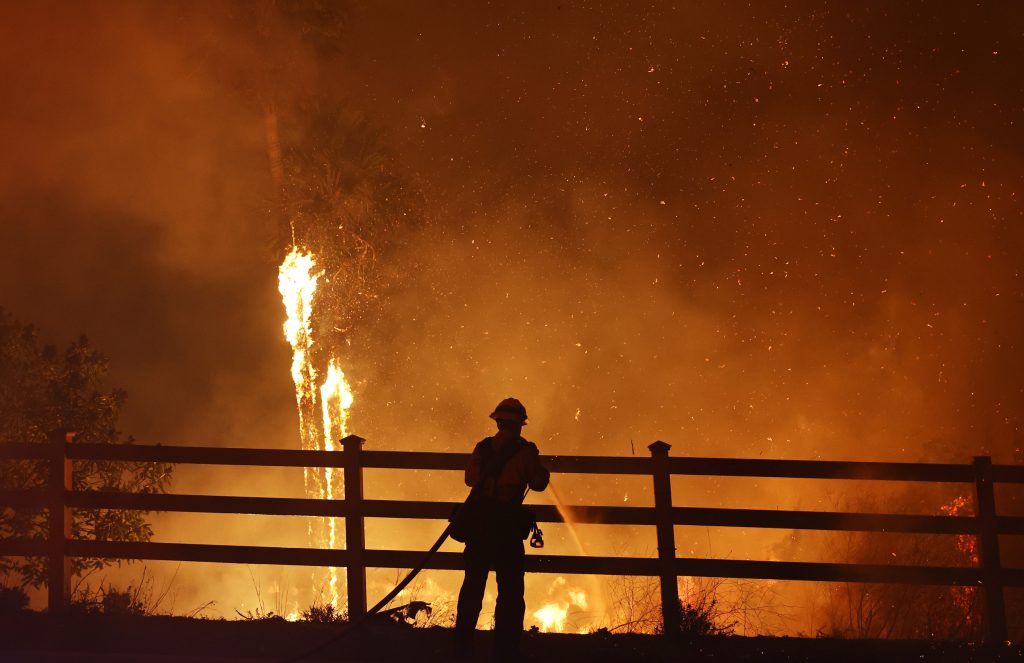The Franklin Fire, a rapidly spreading and highly dangerous wildfire, erupted in Malibu, California, late Monday night, forcing the evacuation of 20,000 residents and scorching over 3,000 acres by Tuesday evening. Driven by powerful Santa Ana winds, the blaze has left a trail of destruction, impacting homes, horse farms, and Pepperdine University. Malibu Mayor Doug Stewart described the unfolding events as a “traumatic 20 hours” for the city. Over 1,500 firefighters are currently battling the inferno, which remains 0% contained. The cause of the fire is still under investigation by authorities. The National Weather Service (NWS) has issued warnings across Southern California, predicting several days of extreme fire behavior due to the dry, windy conditions.
Interactive maps provided by the California Department of Forestry and Fire depict the active fire perimeter, primarily concentrated in the Malibu area. Surrounding areas are under evacuation orders, specifically south of Piuma Road, east of Puerco Canyon Road, and west of Los Flores Canyon Road. Evacuation warnings, urging residents to prepare for potential departure, are in effect for areas including Tuna Canyon Park, Santa Monica Mountains National Recreation Area, Oak Hill, and other nearby locations. The intensity of the fire, coupled with the challenging terrain and unpredictable wind patterns, makes containment efforts particularly arduous. Firefighters are working tirelessly to establish firebreaks and protect structures in the path of the flames.
While the Santa Ana winds are expected to subside by Thursday, meteorologists warn of the potential for further fire ignitions before the wind conditions improve. This underscores the volatile nature of the situation and the persistent danger posed by the dry vegetation and ongoing drought conditions. The unpredictable nature of wildfires, especially under such extreme weather conditions, makes accurate predictions about the fire’s duration and ultimate impact challenging.
Malibu, a coastal community of approximately 10,000 residents located west of Los Angeles, has borne the brunt of the Franklin Fire’s devastation. Known for its celebrity residents, the fire has prompted evacuations of prominent figures, including Cher and actor Dick Van Dyke and his wife. The fire’s proximity to densely populated areas has heightened concerns and intensified evacuation efforts. The loss of homes and property, combined with the disruption to daily life, signifies the profound impact of this disaster on the community.
Fire evacuation zones are designated areas deemed at risk from wildfires, based on factors like fire behavior, weather patterns, and proximity to populated regions. These zones enable authorities to prioritize resident safety, manage traffic flow during evacuations, and coordinate emergency responses effectively. An evacuation warning signals potential danger and advises residents to prepare for possible departure. An evacuation order, however, signifies imminent danger and mandates immediate evacuation due to a direct threat to life and safety. These designations provide a structured framework for managing evacuations and ensuring public safety during wildfire events.
Red flag warnings issued by the National Weather Service indicate conditions conducive to rapid wildfire spread, typically a combination of low humidity, strong winds, and dry vegetation. These warnings serve as a call to action for both firefighters and the public, emphasizing the need for heightened vigilance and precautionary measures. Under red flag conditions, any spark, however small, can ignite a fast-moving blaze. Therefore, activities that could generate sparks, such as outdoor burning or operating machinery with potential ignition sources, are strongly discouraged. These warnings are crucial for raising awareness and mitigating the risk of wildfires during periods of heightened fire danger. The combination of dry vegetation, strong winds, and low humidity creates a tinderbox-like environment, making it imperative to avoid any activities that could potentially ignite a devastating wildfire.










